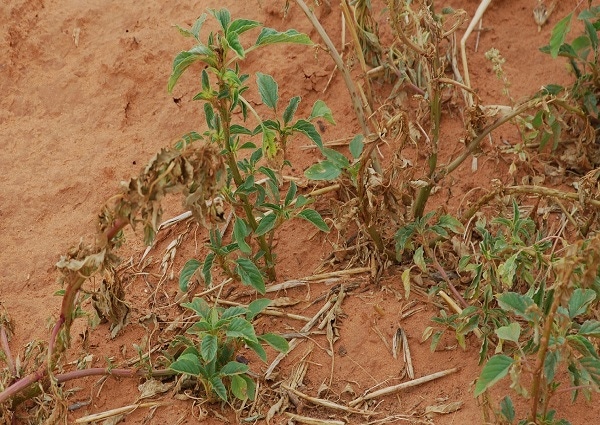
When new resistant weed control technology comes online, most likely next year, farmers will be wise to hang onto to some older strategies to prevent yield loss from competition early in the season, to maintain effective products and to reduce escapes that produce seed and spell trouble for subsequent seasons.
Shane Osborne, Oklahoma State University associate Extension specialist, says pre-plant herbicides, residual products, in-season, over-the-top materials and equipment such as hooded sprayers and cultivators could be part of a comprehensive weed control strategy—even when new herbicide-tolerant weed management systems are fully in place.
Part of the new system will be rolled out this year—new cotton varieties tolerant to Roundup, Liberty and dicamba herbicides. But in-season application of dicamba on cotton will not be labeled for the 2015 season, say industry spokesmen.
Although in-season dicamba use is prohibited this year, Osborne told participants at the recent Red River Crops Conference in Childress, Texas, that tools currently available are still effective against troublesome weeds in cotton, including weeds with proven herbicide resistance. He said horseweed and pigweed are important targets and have shown resistance to Roundup. With either, a pre-plant herbicide program is crucial.
For the latest on southwest agriculture, please check out Southwest Farm Press Daily and receive the latest news right to your inbox.
“We can’t wait for in-season control of horseweed. We have to use an early-season approach and target small weeds. If weeds have already bolted, we have missed the optimum timing. We have to use an effective pre-plant herbicide program.”
While several herbicides are available for horseweed control, 2, 4-D and dicamba are the foundation of an effective strategy. “We can’t wait. We have no effective in-season options for horseweed. Timing is important. By applying appropriate herbicides at the right rate (0.25 pound active ingredient (ai)/acre of dicamba or 1.0 pound ai/acre of 2, 4-D) and the right stage (the rosette stage) we can get good control.”
He cautioned producers to look at plant-back restrictions for 2, 4-D and dicamba and also annual moisture restrictions (not allowed with rainfall averages below 25 inches per year) with dicamba.
Osborne also said pigweed was “the biggest (weed) problem by far,” for Oklahoma cotton farmers last year. “A lot of weeds went to seed so we expect even worse problems this year. It seemed as though every field in 2014 had some pigweed escapes.”
Escapes
He said escapes resulted from several factors, including challenging control conditions as well as herbicide resistance. “In some cases, we went from a challenging situation to disaster,” he said.
Technology is currently available to prevent disaster in most cases. “Yellow herbicides are part of the best control systems,” Osborne said. “Back 20 or more years ago, farmers typically plowed in these pre-plant herbicides to achieve good incorporation.”
That’s not always the case now. No-till and minimum-till production, he said, “results in escapes.” Materials such as Treflan should be incorporated immediately. “With Prowl H2O, we can wait for rain or irrigation. Or we can till it in. With either product, however, you can’t beat tillage to incorporate.”
He said both of those products are effective on Palmer amaranth.
“We have a lot of options with pre-emerge materials, including Prowl H2O, Dual, Warrant and several others. Those have good activity on pigweed but have to be activated by water (rainfall or irrigation. It takes about seven-tenths of an inch to activate most residual herbicides.”
Broadcast, over-the-top options for pigweed include Roundup PowerMax, Liberty, Dual and Warrant. Also, post-emergence directed spray is an option with a hooded sprayer. Products include Caparol, Cotoran, Karmex/Direx, Aim, Valor and MSMA. “We can tank mix with glyphosate,” he said. “Keep these materials off the green stems.”
Tools available
With available technology, even with resistant weeds present, producers can follow an effective weed management program, Osborne said. “Residual herbicides are they keys. Residuals reduce early season competition and the number of trips across the field. In addition the inclusion of residuals adds different modes of action that help sustain current technology.”
He said producers with glyphosate resistant weeds have to map out a program around the resistance. “Again, residual herbicide use is the key. The biggest problem fields we see are ones that did not have residual herbicides applied. And early control is a key factor. The longer weeds stay, the harder they are to control and the more damage they do to the crop.” “And keep options open, including hooded sprayers, Liberty Link varieties and possibly even cultivation.”
He said when the full XtendFlex and Enlist Duo weed management systems are in place producers will have other important tools to manage weeds, especially glyphosate resistant ones. “We already know how well we can control horseweed with dicamba,” he said.
Also, early control of pigweed has been good, but big weeds, 12 inches to 24 inches tall, become much more difficult. . In recent trials dicamba alone controlled about 70 percent of those larger (12- to 24-inch) weeds. That’s not good enough when we’re going after glyphosate resistant species; we see too many escapes in this type of situation. Again, timing is critical. We can do a great job controlling pigweed with dicamba, but application timing will be critical.”
Osborne said Warrant plus dicamba also provides “excellent control.”
Even when the new systems (XtendFlex and Enlist Duo from Dow) are in place, “target weeds will remain the same for a while. Residuals will still be the key. Early control should be the focus to get smaller weeds and to eliminate competition.
“Drift control will be crucial as well.” He said the most effective herbicide applications work well for you and your neighbor. Keeping the herbicide on the intended target increases everyone’s bottom line.
About the Author(s)
You May Also Like






